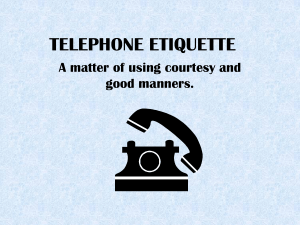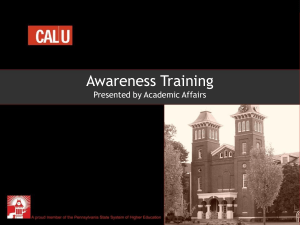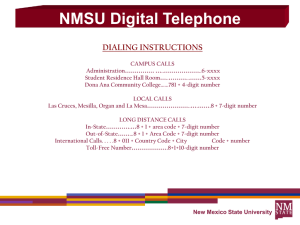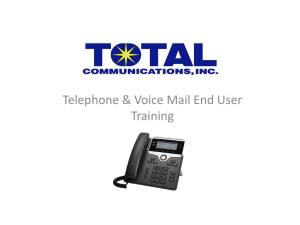Telephone Usage and Etiquette
advertisement
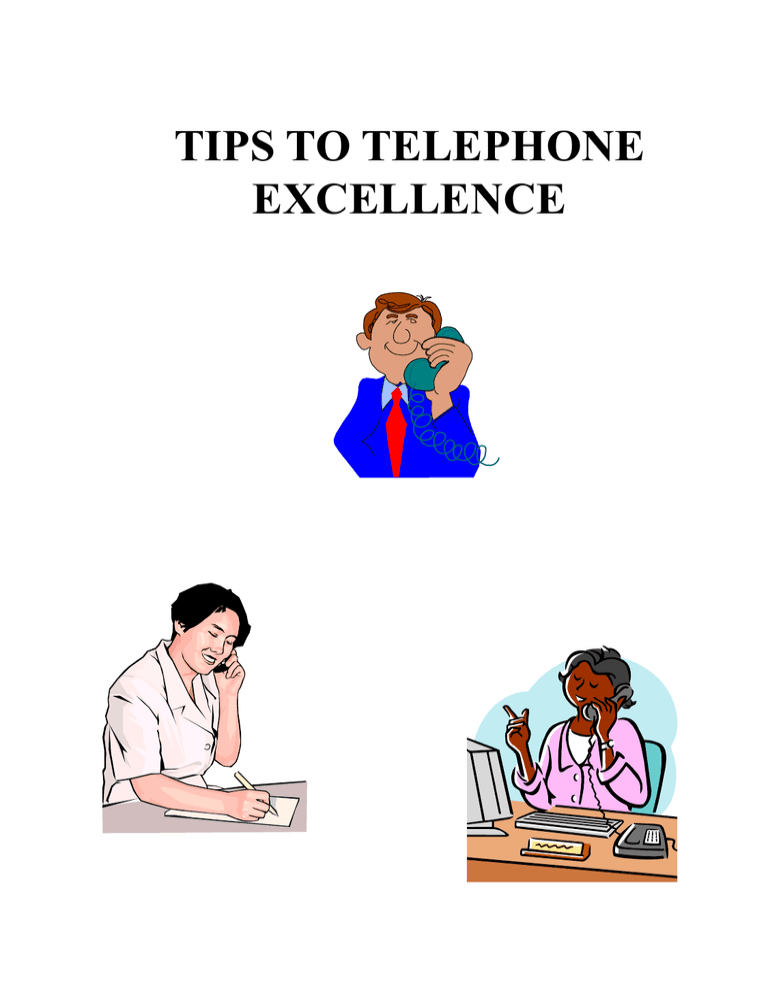
TIPS TO TELEPHONE EXCELLENCE AGENDA • • • • • • • • • Introduction First Impressions Greeting the Caller Listening for Accuracy The Do’s and Don’ts Taking an Accurate Message Telephone Tips Telephone Features Basic Voicemail Procedures 1 Today You Will Learn How To... •Answer the Telephone With Confidence •Take an Accurate Message •Use the Features of the Telephone •Use Voicemail to Enhance Call Handling 2 First Impressions Whenever You Use the Telephone You Become...BIDMC How You Handle Each Call Affects the Image of ...BIDMC A ringing phone is a cue to present your best image to the unknown customer. Answering promptly: • builds a reputation of efficiency • minimizes the disturbance of phone ringing in your office Properly identifying yourself prompts the caller to make the same identification. Your voice is an important part of your personality! Callers only know what they hear: • the quality of your voice • how clearly you speak • your tone and emphasis The caller can’t see all the things that make up your personality. You can sound abrupt, routine, irritated or...Confident, Courteous, and Friendly. It all depends on your TELEPHONE PERSONALITY POWER What You Say and How You Say It Remember, personal attention goes a long way in making a good impression. 3 Greeting The Caller What it is: Greeting the customer initiates the interaction. An effective greeting communicates: Competence, availability, and an interest in providing service. Why it’s important: Your greeting sets the tone of the call. Start Positive, and you increase the chances of having a Positive Call. Your greeting shapes the image the caller has of BIDMC and your department. If your greeting is professional and polite, chances are that the caller will respond in the same manner. Your greeting should provide information to the caller, who wants to know: • whom they have reached • when they can start talking 4 Greeting Contents A greeting contains: • An Opening • The Company / Department Name • Your Name • An Offer of Assistance What is your department’s standard greeting when answering the telephone? __________________________________________________ __________________________________________________ __________________________________________________ __________________________________________________ __________________________________________________ 5 When you are talking on the telephone, others form a mental PICTURE of you. P - PITCH Hi or low pitch I - INFLECTION The way words are emphasized to show the mood of the conversation C - COURTESY May I, Please, Thank You T - TONE How you say it, and the meaning of what you say U - UNDERSTANDABILITY or eat To communicate clearly, don’t chew gum while speaking R - RATE Slow or fast E - ENUNCIATION Syllables may become muffled through the phone transmitter. Mumbling may cause misunderstanding. 6 Active Listening What it is: Active Listening is the ability to recall and organize the information presented by the caller. Why it’s important: It enables you to hear the caller’s verbal message and manner. These are your primary tools in understanding the caller’s perspective. It also helps build YOUR confidence as you demonstrate your ability to understand the reason for their call! Customers are sometimes confused about how to explain their problem and may be looking to you for help. Failing to listen creates opportunities for communication problems. • Wait until you have enough information to respond. • If you respond too quickly it may cost you, or someone else, more time later. Resist distractions, including your own. You may feel: • pressed for time • interrupted by co-workers • anxious to take a break 7 THE DO’S AND DON’TS OF WHAT TO SAY TO A CALLER! DO SAY DON’T SAY “I’ll try to find a co-worker who can help” “I don’t know” “She’s unavailable at the moment” “She’s out” “She’s in a meeting” “She’s not here” “She’s busy with another client” “She’s gone” “He’s busy with another call” “He’s in the bathroom” 8 Techniques For Taking An Accurate Message 1. Have a message pad and pen by the phone Be ready at all times to take a message. 2. Answer promptly and before the 3rd ring if possible The customer cannot see how busy you are. 3. Greet the customer Remember to be friendly and speak clearly. 4. Listen carefully Give your full attention to the customer. 5. Write down message as it’s being given Don’t rely on your memory to write the message later. 6. Use the customer’s name whenever possible At least begin and end with the customer’s name. 7. Verify name, phone number, and the message It’s okay to ask for the information again. 8. Deliver the message quickly We rely on each other to keep the ball rolling! 9 Telephone Tips 1. Answering the telephone A. The telephone should be answered by the third ring; remember the caller cannot see how busy you are. B. Identify yourself to eliminate guesswork. C. Suggested answering phrases: • Greeting: (good morning etc.) name of company / department and your name • For yourself: give your department and name • For others: give other’s name and your name 2. During a conversation A. Speak distinctly in your natural voice. B. Listen carefully, give your full attention to the caller. C. Give a business-like impression at all times. This creates a good image of credibility. 3. Outgoing calls A. Place outgoing calls personally. B. Plan calls ahead of time with the following in mind: • Be sure of the number you are calling. • Have any reference materials ready. • Consider time zone differences. • Is this the best communication medium (how about email). 4. Calls Holding A. Give the caller the option of holding (are you able to hold?). B. Inform the caller he will be placed on hold. C. Return to the line frequently to let the caller know what progress has been made. D. Thank the caller for holding. 10 5. Leaving the office A. Maintain adequate telephone coverage. B. Indicate how long you will be gone and where you can be reached to your co-workers and in your voicemail message. C. Use the “Send Calls” feature when away from your office. D. Use the Extended Absence Greeting in Voicemail when out of the office for more than 1 day. 6. What to have by your telephone • paper and pencil • internal phone directory • telephone directory • reference material • list of frequently called numbers 7. Taking messages A. Have paper and pencil ready and use them, do not rely on your memory. B. Request details courteously; do not demand information. C. Verify numbers and spelling, a jumbled message is worthless. D. Pass message quickly. E. A proper message includes: • For whom the message is being taken • Callers name location and phone number • Time and date • Message • Action to be taken (if any) • Message taker (your name) 11 8. Transferring calls A. Know transfer procedures. B. Help the caller as much as possible. C. Explain to the caller why you are transferring his call. D. Give the caller the name of the person and telephone number to which you are transferring him. E. Relay concise information to party receiving transferred call. This eliminates the need for the caller to repeat their information again. 9. Your voice A. A clear pleasant voice saves time and avoids confusion. You appreciate a person who speaks neither too fast nor too slow neither too loud nor too soft. B. Follow up with the caller at agreed time. This is a crucial step to resolving problems and maintaining customer goodwill. 10. Take Ownership A. Effectively take ownership for all telephone calls by meeting the caller’s need directly. B. Take a message or with the caller’s consent, transfer the call to the appropriate resource or voice mail. C. Respond to all messages within 24 hours. 12 Telephone Features Abbreviated Dialing Abbreviated Dialing allows you to store selected telephone numbers for quicker and easier dialing. The default size of a personal list is 5. To increase, please call telecommunications. To program or re-program a personal list item: 1. Pick up the handset. 2. Dial the AD Program code *00 for West Campus or *0 for East Campus. (dial tone) 3. Dial 1 (The telephone systems list number). (dial tone) 4. Dial the desired list item number (1, 2, 3, 4 ,5). (dial tone) 5. Dial the outside number or extension you want to store. (Do not forget to dial 9 for outside call) - you can store up to 24 digits. 6. Press #. (confirmation tone) 7. Hang up to end programming. To place a call using a personal list: 1. Dial the Abbreviated Dialing code of 101 to access personal list or in some cases the phone will have a programmed button. (dial tone). 2. Dial the desired list item number (1, 2, 3, 4, 5) (ringback tone) The stored number is automatically dialed. Call Park To park a call at your extension (for retrieval at any extension) 1. If a Call Park button has been assigned to your voice terminal, simply press Call Park and hang up; To retrieve a parked call from any extension 1. Pick up the handset and press Retrieve. 2. Dial the extension number where the call is parked. [Confirmation tone] NOTE: If you receive an intercept tone, the parked call has been disconnected or retrieved by someone else. 13 Call Pickup To answer a call placed to a member of your pickup group when your voice terminal is idle 1. Press Call Pickup or dial the Call Pickup code *7. • The called voice terminal stops ringing. • You are connected to the ringing call. To pick up a call while you are active on another call 1. Press Hold . • The present call is put on hold. • The green light flutters. 2. Press Call Pickup . • The called voice terminal stops ringing. • You are connected to the incoming call. 3. To return to the held call after completing the pickup call, press the fluttering ext. Conference To add another party to a call (for a total of up to six parties) 1. Press Conference . [dial tone] • The present call is put on hold, and you are given a new call appearance; all other parties remain connected to each other. 2. Dial the number of new party and wait for an answer. NOTE: You can privately discuss the call with the new party at this time; if no answer or busy, press the fluttering ext. to return to held call. 3. Press Conference again. • All parties are now connected. 4. Announce the call. 5. Repeat Steps 1 through 4 for additional conference connections. To drop the last party added to a conference call 1. Press Drop/Test . • The last party you added is dropped. • You remain connected to the other parties. NOTE: Parties other than the last one must disconnect to be released from the conference call. 14 Consult Activating consult places the caller on hold and establishes a private connection between the principal and the covering user. The covering user can then add the caller to the conversation, transfer the call to the principal or return to the caller 1. Press transfer then consult. The phone number whose calls were sent to you through coverage will automatically ring. 2. Press transfer to transfer the call to the principal. OR: 2. Press Call appearance to return to the caller and take a message OR: 2. Press conference to create a 3 way conference call with the principal, yourself and the caller. Hold To keep a call on hold while you answer another call, make a call, or perform some other task 1. Press Hold . • The green light flutters. NOTE: If you put a conference call on hold, the other parties remain connected. To return to a held call 1. Press ext of the held call. • You are connected to the held call. NOTE: If you are active on a call and you press the ext of the held call, the active call will be dropped. Redial To automatically redial the last number you dialed (extension, outside number, or trunk/feature code) 1. Press Redial or dial the Last Number Dialed code #6 (up to 24 digits). [Ringback tone] 2. Wait for the called party to answer. Priority Calling To place a priority call (3-burst ring) 1. Press Priority or dial the Priority Calling code *1 and pause briefly. [Dial tone] 2. Then Dial the extension. [Ringback tone] 3. Wait for the called party to answer. 15 Reset Speakerphone NOTE: You can adjust the speakerphone to the surrounding room acoustics to provide optimal performance. Use the Reset Speakerphone feature in the following ways: • Whenever you move your voice terminal to another place (even in the same room) • Whenever the green light next to Speaker/Reset Spkr flutters intermittently You may also use this feature when you are on a call in the unlikely event your speakerphone makes a squealing noise during the call. When you press Select and Speaker/Reset Spkr , your speakerphone will adjust itself to normal for that call. (No tones will be heard.) When you hang up from the call, you need to use the Reset Speakerphone feature again to set your speakerphone for future calls. You can initiate the Reset Speakerphone feature when your handset is on-hook, or during a call in which you are using the built-in speakerphone. (If a call is in progress, you will not hear the tones, and the new speakerphone adjustment is reset for only the duration of that call.) Important: If there has been an interruption in power (such as the system has just been powered up again, or you have plugged in the voice terminal at another location), the light next to Speaker/Reset Spkr flutters intermittently until you reset the built-in speakerphone. You can use the Reset Speakerphone feature only if your voice terminal is set for the Speakerphone feature (as opposed to the Speaker feature). To reset the speaker light or adjust the speakerphone to the surrounding room acoustics 1. Press Select or Shift . • The green light next to Select/Shift goes on steadily. 2. Press Speaker/Reset Spkr . • The green light next to Select goes off. • The green light next to Speaker/Reset Spkr flutters intermittently. • You hear a series of tones as the speakerphone performs an acoustic test of the environment. Your built-in speakerphone is ready for use. Send All Calls To send all calls (except priority calls) immediately to coverage 1. Press Send All Calls (while on-hook) or dial the Send All Calls code *3. [Confirmation tone] NOTE: Send All Calls will only work if you have an assigned coverage path. NOTE: You may hear a ring-ping tone from your voice terminal as each call is forwarded. To cancel Send All Calls 1. Press Send All Calls again (while on-hook) or dial the Send All Calls Cancel code #3. [Confirmation tone] 16 Time/Date (Display Feature) To see the date and time 1. Press Date/Time . • The time is displayed on the left-hand side of the bottom line. • After a few seconds, the display returns to normal mode in which only the time appears. Timer (Display Feature) To see the elapsed time (hours, minutes, seconds) 1. Press Timer . • The green light goes on. 2. Press Timer again to stop the timer and clear the display. • The green light goes off. Transfer To send the present call to another extension or outside number 1. Press Transfer . [dial tone] • The present call is put on hold. 2. Dial the number to which the call is to be transferred. [ringback tone] 3. Remain on the line and announce call; if there is no answer or the line is busy, return to the held call by pressing its ext. . 4. Press Transfer again. • The call is sent to the dialed number. NOTE: Only calls from another extension can be sent to an outside number; you cannot transfer a call from an outside number to another outside number. 5. Hang up. 17 BASIC VOICEMAIL PROCEDURES Dial Into Octel using 72300 or from outside 617-667-2300 Enter your password or from outside enter # then your mailbox number and password. Press 1 to Review Messages Press 1 Unheard Voice Messages Press 4 to replay message Press 5 for envelope information (received date/time) Press 7 to erase Press 2 for All voice messages including heard/skipped messages Press 4 to replay message Press 5 for envelope information (received date/time) Press 7 to erase Press 2 to Send Messages Record Message and Press # when finished Press 1 to replay the message Enter destination number or press # to spell name Press # to send. Press 4 for Personal Options Press 3 for greetings Press 1 for personal Greeting Press 2 for Extended Absence greeting Press 3 for name Press 5 to Restart Press * to exit *A Detailed flow chart and instructions can be found on the Care Group web page, General Portal, IS Support, Self Help Training, Voicemail, and choosing the Click Here for the Online Tutorial. 18
